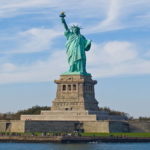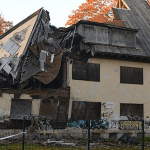 Music
Music  Music
Music  History
History 10 Less Than Jolly Events That Occurred on December 25
 Weird Stuff
Weird Stuff 10 Funny Ways That Researchers Overthink Christmas
 Politics
Politics 10 Political Scandals That Sent Crowds Into the Streets
 Weird Stuff
Weird Stuff Ten Bizarre Facts About The Doge Meme
 Our World
Our World 10 Ways Your Christmas Tree Is More Lit Than You Think
 Movies and TV
Movies and TV The 10 Coolest Stars to Set Sail on The Love Boat
 History
History 10 Things You Didn’t Know About the American National Anthem
 Technology
Technology Top 10 Everyday Tech Buzzwords That Hide a Darker Past
 Humans
Humans 10 Everyday Human Behaviors That Are Actually Survival Instincts
 Music
Music 10 Surprising Origin Stories of Your Favorite Holiday Songs
 History
History 10 Less Than Jolly Events That Occurred on December 25
 Weird Stuff
Weird Stuff 10 Funny Ways That Researchers Overthink Christmas
Who's Behind Listverse?

Jamie Frater
Head Editor
Jamie founded Listverse due to an insatiable desire to share fascinating, obscure, and bizarre facts. He has been a guest speaker on numerous national radio and television stations and is a five time published author.
More About Us Politics
Politics 10 Political Scandals That Sent Crowds Into the Streets
 Weird Stuff
Weird Stuff Ten Bizarre Facts About The Doge Meme
 Our World
Our World 10 Ways Your Christmas Tree Is More Lit Than You Think
 Movies and TV
Movies and TV The 10 Coolest Stars to Set Sail on The Love Boat
 History
History 10 Things You Didn’t Know About the American National Anthem
 Technology
Technology Top 10 Everyday Tech Buzzwords That Hide a Darker Past
 Humans
Humans 10 Everyday Human Behaviors That Are Actually Survival Instincts
Ten Hilariously Bizarre Small-Town Tourist Traps
New York has the Empire State Building. Paris has the Eiffel Tower. London has Buckingham Palace. Los Angeles has the Hollywood sign. We all know those iconic landmarks and tourist attractions set in major metropolises and huge urban centers around the world. Heck, many of you have probably been to at least one or two of those mentioned—and many more!
But what does Wallace, Idaho, have to offer the average tourist? What about Alliance, Nebraska? Niles, Illinois? Ever thought of checking Castroville, California, off your list of places to see? If you’re anything like us, your response to those last four cities is probably something along the lines of “Where is that place?” or “Never heard of it.” And we get it! But as it turns out, these small towns have some really interesting and bizarre tourist attractions of their own!
In this list, we’ll focus our trivia-racked brains on ten tantalizing tidbits that have come out of small-town American tourist traps. These weird attractions are wacky, unique, and memorable. They may not be the Parthenon, the Santa Monica Pier, or the Great Wall of China, but they are strange in their own weird way!
Related: Top 10 Most Overrated Tourist Attractions?
10 Carhenge (Alliance, Nebraska)
Jim Reinders was studying in England as a young man when he went to visit Stonehenge. Impressed and a little awestruck by the massive stones standing out in the open field, he was inspired to bring that same idea home. So, when he returned to his hometown of Alliance, Nebraska, he got to work. Built in 1987, Carhenge is basically the American version of Stonehenge—with automobiles plunged into the ground and standing upright instead of massive stones.
Reinders meant to create Carhenge as a memorial to his late father. The site has become as much of an art piece as a memorial over time—and it’s very much a roadside attraction for people who find their way to Alliance and want to see something strange. Jim himself passed away in 2021, too, so it has become sort of a de facto memorial to him, as well.
In total, there are more than three dozen vintage cars placed and positioned very carefully to mimic Stonehenge. The site’s cars are all painted gray to resemble England’s iconic stones, as well. In recent years, Carhenge has even become home to solstice celebrations and other car- and sun-related festivals. So Reinders’s work and life impact is still going strong! [1]
9 The Museum of Clean (Pocatello, ID)
The Museum of Clean is a 75,000-square-foot (6,968-square-meter) site dedicated to keeping the world clean. The museum, set in the medium-sized town of Pocatello, Idaho, is a shrine to the history of cleaning practices, cleaning tools, and the generally OCD ways some of us have. It’s no small roadside attraction, either, even if it certainly makes for a strange tourist stop in an out-of-the-way locale. The museum has nearly endless exhibits dedicated to the history of cleaning products that go back centuries. And yes, the whole place is spick and span for visitors to roam through! Would you expect it any other way?
Some of the craziest items in the museum include a massive collection of vacuum cleaners that goes all the way back to the 19th century. One of the museum’s rarest models is the “Puffing Billy” vacuum from the 1860s. Ditching modern technology, though, the museum even has a 5,000-year-old broom from ancient Mesopotamia, which proves people way back in the day also wanted things kept clean—even if they didn’t have electricity to help them out. More modern cleanliness products include a shrine to Melville Bissell and a replica of the first Bissell carpet sweeper.
Pocatello’s unlikely shrine goes beyond household cleaning items, though. The museum also has a massive exhibit on industrial and commercial cleaning equipment. Why wouldn’t they, after all? Floor polishers, steam cleaners, pressure washers, and more allow visitors to lean into the history of large-scale sanitation surges. And as if that’s not enough, the museum has a rooftop observatory in which one can see the entire city of Pocatello! It’s not the skyline of New York or London or anything, but for small-town America, it ain’t too bad.[2]
8 The Mystery Hole (Hawks Nest, WV)
The so-called Mystery Hole is one of the more bizarre roadside attractions in America. Located on the side of a highway outside the tiny village of Hawks Nest, West Virginia, the Mystery Hole is pretty much nothing more than a Quonset hut-style building and an old VW Beetle. A man named Donald Wilson created the attraction way back in the 1970s. He claimed that within the building and at the Mystery Hole itself, the laws of physics didn’t apply. Things fell up, gravity was discontinued, and it was a crapshoot whether you would survive your tour. (Of course, everybody did survive, but Wilson had a good sense of humor about it and loved to play with visitors.) The founder charged people $1 to visit the hole, but if travelers didn’t have any money, he waived the entrance fee.
Wilson died in 1998, and it appeared the Mystery Hole would close down forever. However, fortunately for us, another couple bought the site in 1999, and it has remained open ever since. Today, the Mystery Hole is open seasonally to the public from May through October. Visitors can see all kinds of bizarre physics demonstrations with water flowing upward, balls rolling uphill, and more. Many are optical illusions meant to challenge people’s perceptions of space and gravity—and while the whole thing is certainly a little strange, it’s also cool to see science presented in such an offbeat way![3]
7 The Corn Palace (Mitchell, SD)
The tiny town of Mitchell, South Dakota, boasts a building made entirely out of corn and other grains and related Midwestern farm products. Aptly known in Mitchell as the “Corn Palace,” this super-sized structure has actually been around for well over 100 years. The palace was first built in 1892 as a way to honor the contributions of South Dakota corn and grain farmers. It has been rebuilt a couple times since then, and has grown each time.
The current Corn Palace that visitors can walk through today was constructed in 1921. The entire exterior of the building is decorated with thousands upon thousands of bushels of corn. Other grains and prairie grasses make up parts of the building, too. And local residents have put up murals showcasing Mitchell’s creative side!
The Corn Palace isn’t just a maize-made building that you can walk through like a maze. (See what we did there?) Instead, it’s also a major economic driver for the small town of Mitchell. Concerts, trade shows, business conventions, community gatherings, speeches, political rallies, and even sporting events are held there year-round. It has become the Mitchell townspeople’s go-to spot to hang out, get to know each other, and build their community. Now, that doesn’t seem corny at all! (Sorry, we couldn’t resist.)[4]
6 The Leaning Tower of Niles (Niles, IL)
Why go to Italy when you can go to Niles? Wait, what do you mean you’ve never heard of Niles? That’s a minor detail! There’s a leaning tower there—just like the famed Leaning Tower of Pisa far away in Italy—and travelers pushing through the Midwest can visit it and pretend they made it to Europe!
The funniest part of the Leaning Tower of Niles is not only that it is a replica of Italy’s more famous crooked structure; rather, it’s that Niles’ version is exactly half the size of the one found in Pisa! We Americans tend to do things much bigger, louder, and bolder than many of our worldwide counterparts. But not this time! This time, the Leaning Tower of Niles opted to deliver half the height and just a partial profile of the real deal thousands of miles away.
Businessman Bob Ilg was the one who originally built the Leaning Tower of Niles way back in 1934. More than 600 years younger than Pisa’s version, Niles’ tower is anchored in concrete. It was originally meant to be a unique utility tower designed to hide water filtration tanks in a very clever way. Ilg had a big swimming pool in the area at the time, the story goes, and he wanted to hide the ugly tanks and have a little fun.
The tower has since been renovated several times, and in the 1990s, a plaza around the tower was completely altered to make it look like the one in Pisa. There is a fountain, a reflecting pool, and even a plaque claiming the tower was created to honor famed long-dead scientist Galileo Galilei, who dropped things from Pisa’s tower centuries ago to study gravity![5]
5 The Giant Artichoke (Castroville, CA)
The tiny agricultural town of Castroville, California, boasts a giant artichoke statue that exists as a means of local honor. See, Castroville is one of the artichoke capitals of the world. And while there isn’t much else around the small farmer’s village, there is that agricultural gold.
They raise and ship artichokes worldwide, and they are very proud of that fact. So it makes sense that a man named Louis Bertelli built a 20-foot (6-meter) tall statue of a giant artichoke in the center of town many years ago. He owned Bertelli Brothers Manufacturing, and he was the man responsible for making the machines that harvested artichokes from out of the ground.
Today, the Giant Artichoke is a tourist destination for locals and travelers alike. Visitors come to stand next to the massive artichoke, take pictures, and revel in this small town’s very specific and very unlikely claim to fame. But the Giant Artichoke you stand by when you visit Castroville is actually an imposter!
As the story goes, Bertelli’s original artichoke was struck and nearly completely destroyed by a drunk driver years ago. It supposedly rolled through downtown Castroville and fell into a canal, where it settled. We’re a little skeptical about the truth behind that story, but the claim is certainly funny. So, if you ever find yourself in Castroville…[6]
4 The Enchanted Highway (Regend, ND)
We’ve gone through quite a few bizarre roadside attractions and small-town tourist traps so far in this list. And in every one, the draw comes with the ability to get out of your car and snap a picture or pay a couple bucks to visit a museum or see a site. Well, here’s a totally different one for ya, then: a tourist trap that doesn’t even require you to get out of your car!
From the tiny town of Regent, North Dakota, all down Interstate 94 towards the (very slightly larger) tiny town of Gladstone, the “Enchanted Highway” attracts drivers. The highway is nothing more than a very large and bizarre collection of scrap metal sculptures that are placed every couple of miles along the road. Over 32 miles (51.5 kilometers) in total from Regent to Gladstone, you can see a bunch of very random and enormous scrap metal creations just… sitting there.
The first one, at exit 72 on I-94, is a sculpture called “Geese in Flight.” From there, the list goes on: sculptures titled things like “World’s Largest Tin Family,” “Pheasants on the Prairie,” “Grasshoppers in the Field,” “Deer Crossing,” and “Fisherman’s Dream” all make up the line on the way to Gladstone.
Oh, and you can get out of your car and spend some money at the end of it if you so choose. In Regent, there is a gift shop open that sells miniature versions of each sculpture. There’s also the Enchanted Castle Motel, which has both a restaurant for sustenance and some warm, clean beds for rest. You know, if you get tired while driving by the long line of strange roadside metal art.[7]
3 The Center of the Universe (Wallace, ID)
Tucked away high in the mountains in the thin part of northern Idaho lies the tiny town of Wallace. Unbeknownst to most people, Wallace actually plays an important role in the universe even beyond its status as a gas station stop and rest hub along Interstate 90 between the Spokane Valley of eastern Washington and the wilds of western Montana.
That’s because, on the corner of the intersection of Sixth Street and Bank Street in Wallace, you’ll find the center of the universe. Okay, you won’t find the actual center of the universe there. Still, you’ll find a massive manhole cover that claims to be the portal to get to the center of the universe.
Now, to be honest, we’re a little bit skeptical. Would the center of the universe really be tucked away in the tiny hamlet of Wallace, Idaho, way up in the mountains and far from (most) civilization? Wouldn’t it make more sense to have the universe’s portal be in New York City, Los Angeles, London, Tokyo, Jakarta, Mumbai, or any other of the thousands of massive cities built up to the heavens? Nope! It’s in Wallace!
The manhole cover says it, so we’ve got to believe it. Would a manhole cover ever lie? Besides, there’s a Pizza Factory down the street from the so-called “Center of the Universe,” so if the manhole cover DID actually lie, well, at least it’s a very short walk to get some food and forget about it.[8]
2 The Shoe Tree (Middlegate, NV)
As the story goes, one day years ago, a newlywed couple was driving along Highway 50 in northern Nevada after having eloped in the city of Reno. On that long, lonely drive, they got into an argument—their first as married partners. During the argument, the man pulled the car over somewhere outside the tiny town of Middlegate. His bride said she’d rather walk home than continue the discussion.
In response, the man supposedly grabbed her shoes, tossed them into a tree on the side of the road, and left. He drove to the nearest bar in Middlegate, sat down, and began to drink away his sorrows. Thankfully, the bartender convinced him to go back to where he had left his wife and make up with her. He listened to that good sense, did so, and they reconciled.
Legend has it the couple lived happily ever after for the rest of their lives, even with the rocky start. And every single year on their anniversary, they would go back to that very same tree outside Middlegate and toss a pair of shoes up into its branches. Awww! That’s pretty sweet, right? Well, other Nevadans thought so, too, and for years, they trekked to Middlegate to toss pairs of sneakers and other shoes up into the tree.
Sadly, in 2010, a group of vandals came in the night and cut the tree down. But Nevada responded! Locals have since started tossing shoes in a second shoe tree right by where the first one once stood. It may not be quite like the original idea, but the Shoe Tree lives on![9]
1 The World’s Largest Ball of Twine (Cawker City, KS)
When you think about weird American roadside attractions and bizarre small-town tourist traps, the World’s Largest Ball of Twine is pretty much exactly the kind of thing that comes to mind. And Cawker City, Kansas—not exactly on anyone’s “must-see” list of travel destinations—is now a world-famous (or infamous) spot because of it.
It all started on December 24, 1953, when a Cawker City resident named Frank Stoeber decided to create a ball of twine. At home, without much to do on Christmas Eve, he started winding up sisal twine to pass some time on the day before the big holiday. Soon, neighbors got wind of what he was doing and how he simply didn’t stop winding twine in his free time. So, over the next few months, they came by Frank’s house with their own twine and started adding to the ball.
By 1961, the ball was massive, and Stoeber decided to give it to Cawker City’s town government. It was moved to a central location in the tiny town, which is home to about 450 people and sits in a rural section of prairie in the north-central portion of the state. And ever since Stoeber started it seven decades ago, the ball of twine has simply kept growing.
In recent years, it surpassed 20,000 pounds (9,072 kilograms) in weight and is more than 40 feet (12 meters) in circumference. It’s housed under a large canopy to protect it from the weather, but soon, Cawker City is going to need a bigger building to hold it! So, if you’re ever driving along Highway 24 in northern Kansas, maybe you should think about stopping in Cawker City and paying a visit to the World’s Largest (and still growing!) Ball of Twine. Do it for Frank![10]








